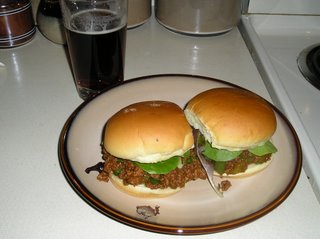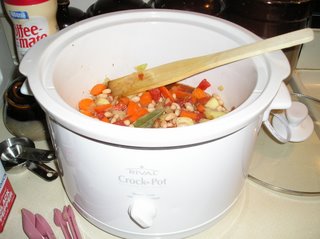
Spicy Sloppy Joes, from
Vegetarian Times magazine, March 2006 issue.
Pronunciation: (Depends on which food product! See the other posts, such as "tofu" or "temepeh" for individual pronunciations).
What is it? (How it's made): Processed soy foods are typically made in factories, although you can make some at home. They can be found in almost any meat-like variation you can imagine. There is "fake": bacon, ham, turkey (both sliced and "Tofurky" for Thanksgiving), bacon sprinkles, burgers, hot dogs, corn dogs, ground beef, meatballs, sausage, chicken, chicken nuggets... It seems like new ones are created daily!
**N.B.- Not all fake meat products are made from soy! Some are made with vegetables, like these incredible portobello mushroom "meatballs" I had from Costco at a recent party.**
History: Interestingly enough, these meat analogs have been around longer than most would think. In China, faux meats were created with tofu and yuba over 1,00 years ago. Once again (see my tofu page and others for more Buddhist references), the Buddhists gave rise to these food items and Japan caught hold of the idea (probably in the 1400s) and created their own. In the U.S., the Seventh-Day Adventists are again credited with the creation of some of our first meat alternatives. In the early 1900s, several innovative people created faux meat products, though some were created from gluten, not soy.
Companies like
White Wave have been making soy foods since the 1970s, and other companies since the early 1900s. They began creating these foods in response to raised consumer awareness of health issues such as cholesterol. Of course, it has been in the past twenty or so years that the "fake meat" products have really taken off, as vegetarianism has become more widely practiced in the United States. These food products have been popular in Asian countries for centuries!
Health benefits: Some of these products, like most processed foods, are high in sodium and other unnecessary things. They are best eaten in moderation (a couple times a week won't hurt, but every day would be overkill). There are so many other foods out there, it would be a shame to overdo these items. Otherwise, they are a convenient source of protein for vegetarians.
Myths and tips: "They won't taste anything like the real thing." Also, "They taste too much like the real thing!" Actually, these foods are touch and go in response to those myths. Some, like the sausage and ground beef style, taste eerily like the real thing (eerie for vegetarians, who might be trying to avoid the meat flavors/textures). Others, like the Tofurky and bacon only taste similar in minute ways.
Tip: These products are often pricy, not to mention high in sodium. Your best bet is to try a few out and find the types and brands that appeal to you. For instance, I really love Morningstar Farms' Spicy Black Bean burgers. They don't taste anything like real burgers but more like... well, a spicy bean pattie! I've also heard that Boca Burgers are the best alternative for meat-eaters, but I've found them to be chewy and not very authentic. Again, you should try out different brands to find your favorites. Read,
"The Soy Daily," for more about the different types and brands.
Tip: Cooking times and procedures for these foods vary, but I have found that grilling the burgers and hot dogs tends to dry them out. Also, unlike traditional grillers, they only need a couple of minutes on the grill and thus tend to be burned by meat-grilling enthusiasts! These are much better in the microwave.
Common uses: The soy crumbles featured above are a great addition to chilis and stews. They were used in the above recipe for Sloppy Joes, and thoroughly enjoyed by my meat-eating husband! The fake sausages are good for breakfast food, but I prefer them cooked in other recipes, such as cassoulet. Most other fake meat food products can be used in the same way that their real counterpart would. Word to the wise vegetarians - try these on yourself before you go serving them to meat-eaters!
Add to this blog! Tell us which recipes you tried, how they turned out, and what you learned about soy meat alternatives!


